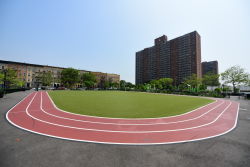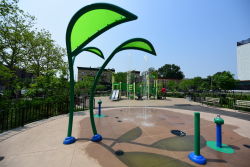Hilltop Playground
Saratoga Ballfields
This ballfield is named for the nearby avenue as well as the Upstate New York town in where, in 1777, America won one of its most decisive victories of the Revolutionary War (1776-1783). A combination of leadership, initiative, and well-timed reinforcement made the Battle of Saratoga a high point in American history.
American troops initially fought a defensive battle, relying on the fortifications of the Polish general Thaddeus Kosciuszko (1746-1817). In spite of this, General Benedict Arnold (1741-1801) chose to go out and meet the British army, rather than wait for an attack. On September 19, 1777, the British army, aided by German mercenary reinforcements, called Hessians, and a shortage of ammunition among the American’s, narrowly defeated the armed colonists at Freeman Farm and successfully pushed the Colonial Army back to their defensive position on Bemis Heights. Still, British General John Burgoyne’s (1722-1792) advancement was short-lived. American reinforcements, a weakening British army, and diminishing British supplies soon combined to produce an important American victory.
On October 7, 1777, Burgoyne attempted another encounter with the American troops, but General Arnold inspired an attack against the German troops holding the British center and succeeded in forcing the English to retreat to the north. Following a miserable march, which involved the construction of 40 bridges, Burgoyne’s troops fell back on the heights of Saratoga, but a reinforced American army surrounded them. Burgoyne waited for British troops who were occupying New York City to come up and reinforce him, but help never arrived. Finally, he attempted to retreat, but was surrounded by an overwhelming American force. On October 17, 1777, Burgoyne surrendered under condition that his men be allowed to return to England. This condition was granted on the understanding that the men would not serve in the military in North America again.
The completeness of the American triumph in the battle of Saratoga convinced France to lend its support to the colonies. The resulting treaty with the French laid the groundwork for the successful resistance against the British and the establishment of an independent country. General Arnold was wounded in the leg at Saratoga, but he recovered and later betrayed the American army. Some speculate that had he died then, he would have been remembered as a hero, instead, his name is now synonymous with treason.
The word Saratoga is thought to have its origins in the Iroquois or Mohawk language, possibly meaning “springs from hillside.” Other supposed meanings include “place of miraculous water in rock” and “beaver place.” The name Saratoga is often used parks and towns in New York State and other parts of the country.
Saratoga Ballfields, located at Hopkins and Saratoga Avenues and Pacific Street in Brooklyn, opened as a schoolyard operated by the Board of Education. In 1990, it became a jointly operated playground, and a backstop was added for softball and baseball. Responsibility for the playground is now shared between the Board of Education and Parks.
Check out your park's Vital Signs
Clean & Safe
Green & Resilient
Empowered & Engaged Users
Share your feedback or learn more about how this park is part of a
Vital Park System










